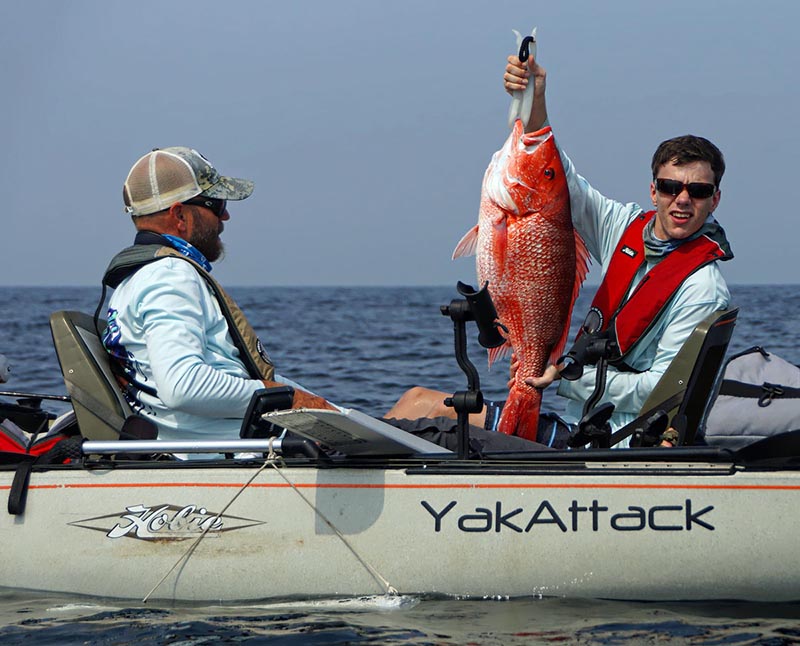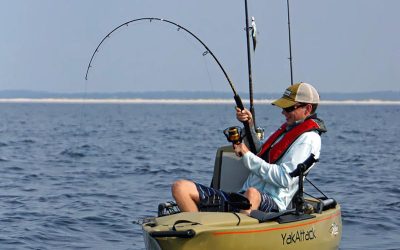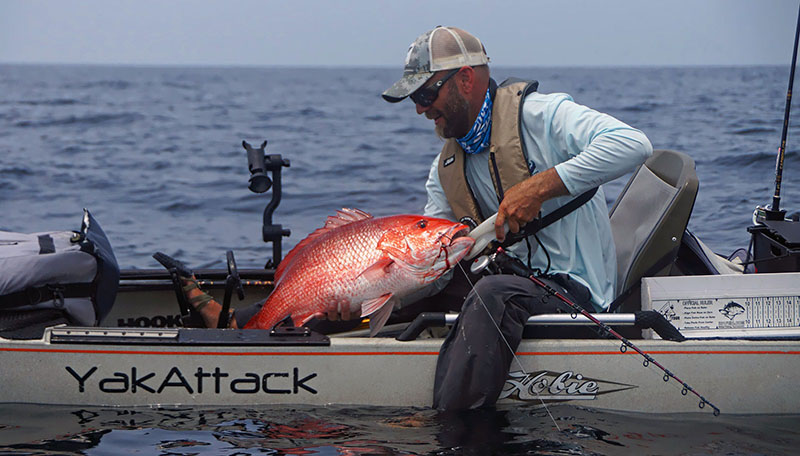
“This is one of the strongest fish you will ever fight. Don’t drop your bait until you are ready to do battle,” I warn my first-time red snapper anglers.
“You need to move the fish ten feet in two seconds. Pump the rod up and reel down, never stopping. Get the kayak moving by using the MirageDrive® to pull the fish away from the structure. If a snapper gets its head turned back towards the reef, it’s game over. Now let’s get them,” I say, ending my pep talk.

Red snapper live around artificial reefs, near bridges and over live bottom – areas where soft corals, sponges and sea fans cover limestone ledges and outcroppings. The waters from Panama City Beach to Pensacola Beach offer access to five piers, numerous artificial reefs and large areas of live bottom. Pensacola Bay’s deep water, artificial reefs and three-mile bridge are home to some of the meanest snapper that swim.
The first step is to find areas that hold red snapper. A good depth finder/chart plotter is the most important tool for this task. I use my Lowrance to locate suspended bait and scan the bottom for structure. Structure is crucial. The more relief the better. Large areas of live bottom also hold bait and likely red snapper.
Once a productive area is located, the second step is figuring out how the snapper are relating to the structure and bait. Current, water clarity, time of year, the amount of pressure from anglers as well as the presence of large predatory fish in the area are all factors that will determine where the fish are holding and if they will eat.
Kayak positioning and bait presentation are critical components to success. Current and wind are the two main factors. The current affects the bait while the wind affects kayak positioning. Keeping the kayak pointed into the wind and using the MirageDrive to hold position or slow the drift will keep the bait in the strike zone longer. The longer the bait is in the sweet spot the better. For live bait, I use cigar minnows, threadfin, speedos, croakers and pinfish. For cut bait, I use bonito, mackerel and menhaden. The tackle and technique determine how to set up on the reef.
Bottom dropping is the most common way to catch snapper. I use two different rigs.
The Carolina rig and knocker rig both use 3- to 5-ounce egg sinkers on 50-pound braided main line, with a 40- to 60-pound fluorocarbon leader tied to a 5/0- to 7/0-circle hook. The Carolina rig has a swivel and 3-foot section of leader that works well with less current and allows the bait more freedom to move. The knocker rig has a 7- to 10-foot section of leader connected directly to the mainline allowing the sinker to slide all the way to the hook, which drops through the water column faster in stronger current.
I also use one-quarter to 1-ounce circle hook jigs on 40- to 60-pound fluorocarbon leader to target suspended fish higher in the water column. This technique often produces the largest fish.
Chunking is my favorite way to catch red snapper. After positioning the kayak up current of the reef, I throw small pieces of cut bait into the water. As the chunks descend towards the reef, the fish swim up in the water column right under the kayak. Once I see the snapper, I cast up current and free line a small piece of cut bait the same size as the chunks into the current using 10 to 12 feet of 40- to 50-pound fluorocarbon leader connected directly to 30- to 50-pound braided mainline with a 6/0 circle hook. It is critical for the bait to sink at the same rate as the chunks. Watching a large snapper sip down your bait on lighter tackle 15 feet below the kayak gets the adrenaline pumping. There is no more exciting way to hook these fish. Landing them can be a great challenge.
Every year anglers travel from far and wide to the northern Gulf of Mexico to do battle with the red snapper. No matter how or where you catch a red snapper in your kayak, you have earned it! One thing is for certain, you will enjoy eating or releasing your prize catch.
PHOTO CREDITS: Matthew Vann.





